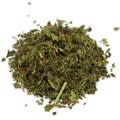
Sassafras (Sassafras albidum), also known as Sassafras, White Sassafras, Red Sassafras, or Silky Sassafras, is a species of Sassafras native to eastern North America, from southern Maine and southern Ontario, west to Iowa, and south to central florida and eastern Texas. It occurs throughout the eastern deciduous forest habitat type.
An essential oil, called sassafras oil, is distilled from the root bark or the fruit. It was used as a fragrance in perfumes and soaps, food (sassafras tea and candy flavoring) and for aromatherapy. The smell of sassafras oil is said to make an excellent repellent for mosquitoes and other insects, which makes it a nice garden plant. Acids can be extracted from bark for manufacturing perfumes.
The essential oil was used as a pain killer as well as an antiseptic in dentistry. The pith is used in the U.S. to soothe eye inflammation and ease catarrh.
Sassafras oil is the preferred source of safrole, which is the main component (75-80%) of the essential oil.
A yellow dye is obtained from the wood. The shoots were used to make root beer, a traditional soft drink beverage carbonated with yeast, which owed its characteristic odor and flavor to the sassafras extract. Most commercial root beers have replaced the sassafras extract with methyl salicylate, the ester found in wintergreen and black birch (Betula lenta) bark. A safrole-free sassafras extract is now available for flavoring.
The dried and ground leaves are known as filé powder. Filé is still used for thickening sauces and soups in Cajun, Creole, and other Louisiana cooking, notably in the dish filé gumbo.
